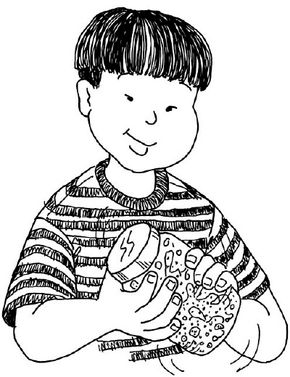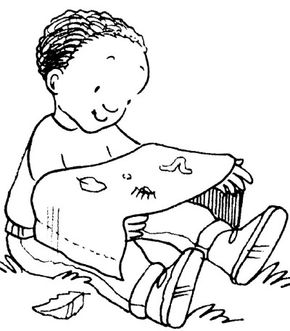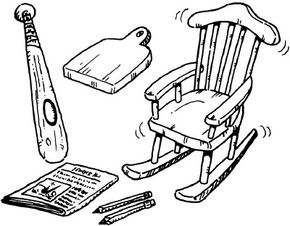 “It’s easy to learn with Settle For Dirt and other easy science projects.©2007 Publications International, Ltd.
“It’s easy to learn with Settle For Dirt and other easy science projects.©2007 Publications International, Ltd.
Science is fun once it becomes easy — and these easy science projects for kids will show you how. Kids will learn about the world around them as they look more closely at dirt, rocks, trees, and minerals.
These easy activities will set kids on the road to satisfying their scientific curiosity. Who knows where it will lead!
Let the easy science projects begin by following these links:
Grow Your Own Sugar Cane
Sugar cane is sweet and you can grow your own in this easy activity. Learn more.
Settle For Dirt
In this easy science project, you’ll discover that dirt always knows the right way to settle. Keep reading to find out more.
What Lives in a Tree?
All kinds of creatures live in trees. See them up close in this science activity.
Be a Mineral Detective
Ever wonder what household items are made of? Find out what contains calcium carbonate in this easy science project.
Knock on Wood
So many things are made of wood. See how to find them!
Deep Freeze
Find out what happens when liquids freeze in this easy science project.
Read a Weather Map
Kids can become weather experts after learning to read a weather map. Find out more.
Divide and Conquer Houseplants
Make the most of your houseplants in this kids’ activity. Learn more.
In the first easy science project, grow your own lovely indoor sugar cane.
For more easy and fun kids’ activities, see:
- Easy Crafts for Kids
- Easy Outdoor Science Activities for Kids
- Easy Outdoor Science Experiments for Kids
Contents
- Grow Your Own Sugar Cane
- Settle for Dirt
- What Lives in a Tree?
- Be a Mineral Detective
- Knock on Wood
- Deep Freeze
- Read a Weather Map
- Divide and Conquer Houseplants
Grow Your Own Sugar Cane
Grow your own sugar cane — it’s one sweet and easy science project idea. Not only does this kids’ science activity look great, you’ll have your own sugar cane to use.
What You’ll Need:
- Sugar cane
- Potting soil
- Large flower pot (about eight inches)
- Knife
- Candle
How to Grow Your Own Sugar Cane:
Most people don’t know that sugar cane is a type of grass. Like grass, it grows quickly and easily into an attractive plant.
Step 1: Find a fresh-cut section of sugar cane at least a foot long. (You may have to look in a specialty grocery store.)
Step 2: Look near the joints in the stem for a shield-shaped bud from which new stalks will grow. Below the buds are tiny holes where roots will grow. Cut the stalk off two inches below the bud and about an inch above the next joint.
Step 3: Fill a flower pot with potting soil up to about two inches from the rim. Stick the cane into the soil so that the bud is just barely covered.
Step 4: Light the candle and drip melted wax onto the other end of the cane to keep it from drying out.
Step 5: Keep the soil barely moist. In a week or two the bud will sprout. When the new sprout is about six inches high, add another 1-1/2 inches of potting soil.
Step 6: As more sprouts grow you can cut the sprouts, peel them, and cut them into sticks to stir hot drinks with.
See how dirt falls into layers of sediment in the next easy science project.
For more easy and fun kids’ activities, see:
- Easy Crafts for Kids
- Easy Outdoor Science Activities for Kids
- Easy Outdoor Science Experiments for Kids
Settle for Dirt
 “The Settle For Dirt easy science project for kids.©2007 Publications International, Ltd.
“The Settle For Dirt easy science project for kids.©2007 Publications International, Ltd.
In "Settle for Dirt," kids can see first-hand how sediment is made. When soil, sand, and other materials settle at the bottom of a lake or pond, it is called sediment. Over time, layers of sediment can form rock. See if kids can replicate this natural process with this easy science activity.
What You’ll Need:
- Jar with lid
- Soil
- Sand
- Gravel
- Water
- Small plastic animals (optional)
How to Settle For Dirt:
Step 1: Put a handful each of soil, sand, and gravel into a jar. Fill the jar with water. Put the lid on tightly.
Step 2: Shake the jar well until everything is mixed together. Now let the jar sit overnight.
Step 3: In the morning, see how the different things in the jar have settled. How would you describe what you see? What can you say about the layers? Compare your layers to what happens in a lake or pond.
Step 4: If you want to see how fossilized critters are made, put small, plastic animals in with your soil, sand, and gravel mixture.
In the next easy science project, shake a tree and see what falls out.
For more easy and fun kids’ activities, see:
- Easy Crafts for Kids
- Easy Outdoor Science Activities for Kids
- Easy Outdoor Science Experiments for Kids
What Lives in a Tree?
 “Try the What Lives in a Tree easy science project for kids.©2007 Publications International, Ltd.
“Try the What Lives in a Tree easy science project for kids.©2007 Publications International, Ltd.
"What Lives in a Tree?" is an easy science project that lets kids discover a tree’s smallest inhabitants. When you shake a tree, you never know what will fall out in this easy kids’ activity.
What You’ll Need:
- A tree with an easy-to-reach branch
- White bed sheet
- A partner
- Magnifying glass
How to Do What Lives in a Tree?:
Step 1: Have a partner help you stretch a white sheet under a tree branch. (The closer you hold the sheet to the branch, the better.)
Step 2: Shake the branch hard for about a minute, then lay the sheet on the ground and observe with a magnifying glass. What tiny animals do you see? Look for spiders, adult insects, and caterpillars.
Step 3: Now try the same activity with a different tree. Do you find the same animals in a pine that you do in an oak? Record your findings and compare.
Step 4: Try sampling the same tree several times in a year. Do you see different insects at different times?
Be a detective in your own home in the next project and identify objects containing a certain mineral.
For more easy and fun kids’ activities, see:
- Easy Crafts for Kids
- Easy Outdoor Science Activities for Kids
- Easy Outdoor Science Experiments for Kids
Be a Mineral Detective
In this easy science project, be a mineral detective and discover calcium carbonate in your home. Calcium carbonate is one of the most common minerals in nature. Kids can root it out with their sleuthing skills in this easy science project.
What You’ll Need:
- Wide-mouthed jar
- Vinegar
- Raw egg (in the shell)
- Different kinds of chalk
How to Be a Mineral Detective:
Both eggshells and limestone contain calcium carbonate, and some chalk is made from it.
It’s simple to find out whether or not a substance has calcium carbonate in it. Simply drop a sample into a jar of vinegar. If the vinegar dissolves (or partly dissolves) the substance, it contains calcium carbonate.
To try this, fill a wide-mouthed jar with vinegar. Gently place a whole egg in the jar. Watch the eggshell begin to fizz. Over a couple of days, it will completely dissolve! That’s because an eggshell is almost all calcium carbonate.
Try the same thing with several different chalk samples. If the chalk is made from calcium carbonate, it will fizz and at least partly dissolve. Some chalk is made from another mineral called gypsum, which will not fizz and dissolve in vinegar.
What other materials are your household items made of? See what’s made of wood in the next easy science project for kids.
For more easy and fun kids’ activities, see:
- Easy Crafts for Kids
- Easy Outdoor Science Activities for Kids
- Easy Outdoor Science Experiments for Kids
Knock on Wood
 “Try the Knock on Wood easy science project for kids.©2007 Publications International, Ltd.
“Try the Knock on Wood easy science project for kids.©2007 Publications International, Ltd.
The Knock on Wood easy science project teaches kids that trees give us more than just a shady spot on hot summer days. Find the products that trees provide in the Knock on Wood project.
How to Knock on Wood:
Do you have a baseball bat? How about a pencil? Does your home have a wooden table or chairs?
There are so many things made from trees it’s hard to count them all! Try to walk around your house and find as many things as you can that came from trees.
Look for wooden items, as well as paper and cardboard. Don’t forget to count fruit — such as apples — that grow on trees.
In the next easy science project for kids, see what happens when liquid freezes inside an object.
For more easy and fun kids’ activities, see:
- Easy Crafts for Kids
- Easy Outdoor Science Activities for Kids
- Easy Outdoor Science Experiments for Kids
Deep Freeze
In the Deep Freeze easy science project, kids will discover how rocks break. Winter can be hard on everybody — even on rocks. See how the cold affects more than just your toes with the Deep Freeze experiment.
What You’ll Need:
- Egg
- Small sealable plastic bag
How to Do Deep Freeze:
Step 1: Put an egg in a sealed plastic bag and put the bag in the freezer overnight.
Step 2: In the morning, see what the freezing temperature did to the egg. When the egg freezes, it expands and breaks its shell. Winter freezes do the same thing to rocks that have moisture in them. The moisture expands as it freezes, causing the rocks to break.
Step 3: When you’re out walking in the winter, see if you can find rocks that have been in nature’s deep freeze. A rock that is broken into pieces but still lying in its original shape is probably a victim of winter’s icy strength.
Next, kids can learn how to read a weather map for an easy science project.
For more easy and fun kids’ activities, see:
- Easy Crafts for Kids
- Easy Outdoor Science Activities for Kids
- Easy Outdoor Science Experiments for Kids
Read a Weather Map
Read a weather map, and take part in an easy science project that provides an excellent opportunity for learning. Kids will be able to tell more than just temperatures after learning how to read a weather map.
What You’ll Need:
- A newspaper weather map
How to Read a Weather Map:
Take time to learn how to read the weather map in your local newspaper.
Check the key to learn what all the different symbols and colors mean. You might see numbers that stand for high and low temperatures, lines that show warm and cold fronts, and symbols that point out where it may rain or snow.
These symbols are used by meteorologists (weather experts) all over the world. Read the weather map every day for at least a week. What weather patterns do you see?
One plant becomes many plants in the next easy science project.
For more easy and fun kids’ activities, see:
- Easy Crafts for Kids
- Easy Outdoor Science Activities for Kids
- Easy Outdoor Science Experiments for Kids
Divide and Conquer Houseplants
Kids will divide and conquer houseplants in this easy science project. No need to buy new ones! Kids will be all green thumbs after this one.
What You’ll Need:
- Houseplants (such as African violet, begonia, or geranium)
- Knife
- Small bottle
- Flower pots
- Potting soil
- Perlite or vermiculite (optional)
How to Divide and Conquer Houseplants:
Step 1: Take a knife and cut a section of a houseplant stem with five or six leaves on it. Trim away any flowers and cut off the bottom three leaves.
Step 2: Fill a small bottle with water and place the stem of the cutting into the water. The remaining leaves will hold the cutting in place. Put the bottle near a sunny window but not in direct sunlight. Add water to the bottle as needed to keep the stem in water.
Step 3: After a few weeks the cutting should have long roots and be ready for planting. Fill a small flower pot with potting soil up to about 1/2 inch from the top. Dig a hole large enough for the roots. Lower the cutting in and carefully cover the roots.
Step 4: You can also start cuttings in vermiculite or perlite, which are heat-expanded rocks. You can buy them at a garden store. Fill a small jar with vermiculite or perlite and add water.
Step 5: Take a cutting as described above. Poke a hole in the vermiculite or perlite and lower the cutting into it. Allow roots to grow for three weeks, adding water as needed. After the roots have grown, pot up in potting soil.
For more easy and fun kids’ activities, see:
- Easy Crafts for Kids
- Easy Outdoor Science Activities for Kids
- Easy Outdoor Science Experiments for Kids
ABOUT THE ACTIVITY DESIGNERS
What Lives in a Tree? by Maria Birmingham, Karen E. Bledsoe and Kelly Milner Halls.







































